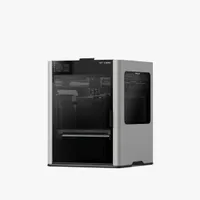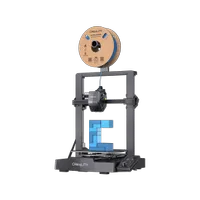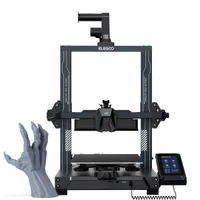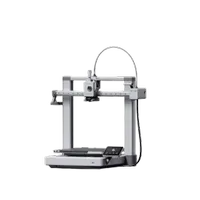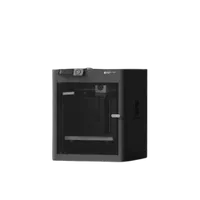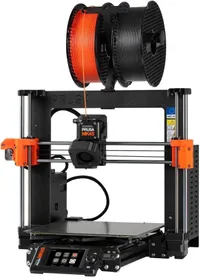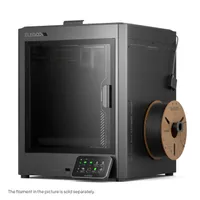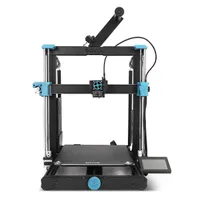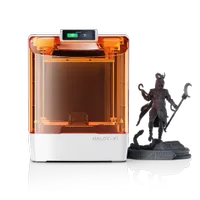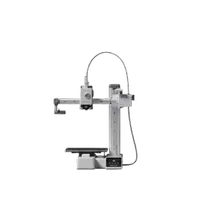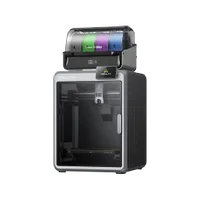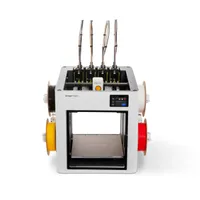My 16 favorite Black Friday 3D printers based on comprehensive testing - get these great deals on my top-performing 3D printers
From prototyping to miniatures, now's the time to grab my favorite 3D printing deals for Black Friday

I've tested, benchmarked, and reviewed over 50 of the best 3D printers - but for Black Friday, I've whittled that list down to my favorite 16 models all with big discounts for the sales season.
My number one pick is the Bambu Lab H2D now $1479 direct from Bambu Lab (was $1999). The H2D is also on sale in the UK for £1399 (was £1599). I was seriously impressed with this machine when I reviewed it, calling it one of the most impressive 3D printers on the market, and a compact, multi-functional unit for manufacturing in your home, office, or workshop.
But it's not the only 3D printer on sale right now. With the Black Friday 3D printer deals dropping, I've been checking my direct emails to find the best discounts on my top-performing models.
So, to help you make sense of what's out there right now, I've broken down the machines down into five different sections, from cheap Black Friday deals to units that will definitely satisfy business professionals looking to prototype or run small production runs. Thankfully, there's plenty to choose from, and what I'm trying to do here is pick a few specific areas of use to better help you make an informed decision about which 3D printer is best for you.
My top Black Friday 3D printer deal
Read moreRead less▼
When the H2SD was announced earlier in the year, it caused quite a stir with its dual-nozzle rocker design and ability to quickly swap mountable tool heads. These heads not only sped up the printing process but also allowed it to be used as a laser cutter, CNC and plotter. The machine has since been developed into several different iterations, with the latest H2C featuring a much-anticipated multi-change nozzle setup. Whilst it seems the technology has moved forward, the H2D is not only the machine that started this new flagship range, but it's still one of the best on the market. The base machine is now heavily discounted for Black Friday, and in my review, I found it a great option for all types of use, whether at home, in an office, or in an educational environment.
Black Friday 3D printer deals on a budget
Read moreRead less▼
While the technology might have been superseded by the latest CoreXY and Voron-style machines, there's still a place for the likes of the Creality Ender-3 V3 SE 3D printer I reviewed in 2023. This machine, along with a few others from major manufacturers, showed the refinement of Cartesian mechanics. Whilst these machines might have been overtaken by faster counterparts, they were still able to print at 250 mm/s and featured options such as auto levelling, print accuracy, and a very decent print area. The open design is also a great way to learn about 3D printing. If you not only want to print models but also be able to see exactly how the printer works and better understand the technology, then this is a great option. It's limited to a single filament, but with the precision and accuracy of the prints, it's a great machine if you just want an easy way to prototype or model more complex items.
Read moreRead less▼
The Elegoo Neptune 4 Pro is another seemingly basic machine, but it really shows the quality Elegoo is capable of, creating some of the best Cartesian machines ever made. The design is simple and typical of the open-frame 3D printers that mark the evolution of the open-source community. However, here it utilises a powerful direct extruder, the latest Klipper firmware and offers a large build volume of 225 x 225 x 265 mm. It's one of the largest print platforms for its footprint. There are some impressive innovations here, including an intelligent segmented heat bed that only heats the small centre section for smaller prints, helping save energy. I found in my review it can also print at up to 500 mm/s, making it one of the fastest Cartesian models before the switch over to CoreXY.
Read moreRead less▼
When Bambu Lab launched the A1, the price, speed and features were hard to believe, and now for Black Friday, the single filament version (that's the one without the AMS) offers exceptional value featuring the latest technology in one of the easiest-to-use systems to hit the market. It could be argued that this set of printers helped elevate 3D printing to the mainstream. In my review, I found the machine is lightweight, easy to use and has one of the best-designed user interfaces. Aimed at those new to 3D printing, the full auto calibration, reliability and impressive print quality make it stand out. The single filament version is also fully upgradeable to the combo version, offering multifilament printing through the AMS Lite system, making it one of the first cheap 3D printers to offer easy-to-use multifilament support straight out of the box. If you're on a budget and want a great 3D printer with the ability to upgrade to multifilament later, this is a superb option for the price.
Black Friday 3D printer deals for business, design & prototyping
Read moreRead less▼
Bambu Lab broke into the market with the P1S, one of those defining machines that, along with the X1C, essentially changed the market. It proved that exceptional multifilament printers could be both reliable and ultimately affordable. The machine also supported a fully enclosed environment, which offered a better enclosure for more advanced materials such as ABS and nylon. The P1S came with the first of the AMS units, essentially a multifilament box, that enabled four-material printing from the outset. However, it was more than just a simple box; it allowed for additional units, boosting filament input up to 16 spools. This was quite revolutionary when the P1S first appeared, making it a firm favourite and a more budget-friendly option than the superb X1C. As with all Bambu Lab printers, what makes them so popular is the ease of setup and use. Whilst it might not have the ultra-sleek LCD interfaces of the newer Bambu Lab printers, it's still relatively simple to navigate and use at all levels.
Read moreRead less▼
The Prusa Core One is, without doubt, one of my favourite 3D printers. In a competitive market, it stands out as the last remaining open-source machine and one of the final predominantly single-filament options. It's also one of the most reliable and accurate machines that I've reviewed and is great for a variety of different projects, from prototypes to small production runs with specialist materials. Since its release, Prusa has continued to develop and release small upgrades to the Core One+, with a few additions to the initial version I looked at. The latest firmware gave the machine a huge speed boost earlier in the year. There's also the option to add the MMU3 if you want multifilament printing, but the key point is this: if you run a print farm or a business and just need a reliable workhorse that won't let you down and can be fixed relatively easily, then for me, the Core One+ is still the machine to go for. While the machine itself hasn't been heavily discounted for Black Friday, Prusa is including plenty of extras, including a reel of filament, the 3D camera, and access to their Prusa Academy courses, giving both new and experienced users considerable value for the money.
Read moreRead less▼
The Original Prusa MK4S was the last of a generation of true Cartesian open-source machines. It's probably one of the last that actually looks like you could build it yourself, so I had to pop the kit version into this Black Friday round-up. This base design essentially launched the open-source community of 3D printing, and it's iconic in itself. Although the machine has been available for a couple of years, even with all the upgrades this particular model features, it still commands a relatively high price. However, if you run a business and want a solid machine that's slightly more affordable than the Core One+, then I found the MK4S is a great option, and this kit version will teach you about every part through the construction process. What's more, there's an upgrade kit from the MK4S to the Core One+ so if you want the machine enclosed at a later date then there's an upgrade path. Essentially, when you buy a Prusa, you're investing in your future progression through the 3D printing family. For Black Friday, rather than a direct discount on the machine, Prusa is including $220 worth of accessories, including access to their Prusa Academy courses and a series of premium model files.
Black Friday 3d printer deals for crafts
Read moreRead less▼
At this price, Elegoo’s Centauri Carbon really shouldn't have been as good as it is, especially considering it's a carbon-ready printer featuring CoreXY mechanics and an easy-to-use touchscreen interface. There were a few quirks I noted in my review, and many users expected a multifilament option to boost its capabilities, but that unfortunately never arrived. There is now the Centauri Carbon 2, which again is a solid machine. What makes this printer stand out is that it's unusual for a machine at this price to handle advanced materials so well, but the Carbon managed it with ease. With its fully enclosed environment and top speed of 500 mm/s, it has become a firm favourite for single filament printing, especially for prototyping, modelling and making functional parts.
Read moreRead less▼
The Sovol SV06 has started to earn a name for itself as a solid, large-scale 3D printer with a massive 300 x 300 x 350 mm print volume. It also offers speeds up to 500 mm/s, and the company has really focused on build quality to ensure exceptional performance at what is essentially a budget price. The great thing about this printer's size is that if you're into cosplay, crafts or general maker projects, it provides plenty of space. With its reliable build quality, it's a firm foundation for printing anything from helmets to electronics enclosures and even drone chassis. The open nature of the printer means you're limited to less technical materials, but for PLA, it absolutely excels. Why I think it's great for makers is that it's completely open-source, so you can customize both the hardware and software to suit your needs. Side-note: I checked, and it will ship to the UK.
Read moreRead less▼
Anycubic machines have come a long way, and the Kobra range has always been known for being fast and reliable. It's one of the machines I often see in educational settings due to its balance of price and performance. The Anycubic Kobra 3 impressed me when I looked at it earlier this year. It was extremely affordable and offered solid reliability, plus a multifilament option that was straightforward to use. It delivered superb quality prints and, despite being at the cheaper end of the market, has proven to be a reliable workhorse for mid-sized multifilament printing. In my review, I found this machine is also easy to use and maintain with plenty of support, making it a great option for beginners looking for their first maker machine. It offers a good level of automation and trouble-free printing at a very reasonable price, especially considering it includes multifilament capability.
Black Friday 3D printer deals for miniatures
Read moreRead less▼
If you're into tabletop gaming or miniatures, then while you can print a decent range on an FFF printer, what you really need is resin. The Elegoo Saturn 4 Ultra is a mid-range resin printer that offers a host of advanced features, including a COB and Fresnel lens system that enables faster, smoother surfaces than other resin printers at this price point. It also offers hands-free automatic levelling, which impressed me when I reviewed the machine earlier this year, as it removed much of the hassle of resin printer setup. With a 12K screen, the print quality and resolution are exceptional. So, if you value miniature quality, the Elegoo not only delivers, but I also found it extremely reliable.
Read moreRead less▼
This is one of the smallest resin 3D printers I've looked at. There's nothing overly complex about the machine, but what I like is the compact size; it allows you to place it almost anywhere and print extremely accurate miniatures for tabletop gaming. The small platform size does limit it to miniatures or other small objects, but if you're a jewellery maker or miniature designer, it's ideal. Because it's compact, it also uses minimal resin per print, so it feels cheap to run. The small size doesn't affect quality either, with a 7-inch high-definition screen offering 10K resolution, which is unusual at this entry-level price. If you're just getting into resin 3D printing or want to try it on a budget, the Photon Mono 4 is an excellent option.
Read moreRead less▼
With the resin side of Creality's business now spun out into a new company, some of the older Creality-branded resin printers are now on sale at heavily discounted prices. While the company has even cheaper resin options available for Black Friday than the Halot-X1, this sits at the top end of the range and offers exceptionally fast printing at 170 mm/hour, high precision, a 16K ultra-HD LCD mono screen, and smart resin management. It also features a very intuitive and user-friendly design that enables high-quality prints at this price point. What really stood out to me about this machine is the print platform, which makes it easier to release printed models. If you require absolute quality in your 3D miniature prints, the Halot-X1 is one of the best machines at this price.
Black Friday 3D printer deals for education
Read moreRead less▼
During my tests, I found the Bambu Lab A1 Mini is a very cheap and reliable 3D printer. It's exceptionally small, so in an educational environment, it's easy to pick up and store in a cupboard. Even though this is the entry-level model, it's fully compatible with the rest of the Bambu Lab ecosystem. So if you want to run this alongside the latest H2C in the same print farm, that's perfectly possible. For any classroom, the small size means you can have more than one machine running at the same time, giving all students the ability to print their Tinkercad designs during the session and observe how the printing process works on a small, well-refined machine.
Read moreRead less▼
The K2 Combo is an ideal option for STEM education, offering a fully enclosed environment that enables the use of more advanced materials as well as standard PLA. It also features a multifilament bar that supports up to four materials in the CFS, which can be upgraded to 16 with the addition of more units. One of the features that makes this a great classroom option is the fully enclosed design, ensuring students' fingers won't get near the print head while it's operating. With its easy-to-use interface and compatibility with Creality RFID filaments, which are automatically recognised by the printer, it offers a good level of automation. This makes for trouble-free printing in classrooms, where teachers already have plenty to manage.
Read moreRead less▼
Once in a while, a 3D printer comes along that genuinely shakes the market, and this year, despite several impressive machines from other manufacturers, the Snapmaker U1 has stood out in my testing. It's a true multitool machine that lives up to its Kickstarter hype. It offers four tool heads out of the box, enabling the use of four different filaments on a single model. Unlike many other multifilament machines, it doesn't need to purge material between filaments, as each has its own print head, reducing print times and filament waste. This saves time and money in the classroom. Through our testing, Snapmaker's first four-tool-head system has proven a bold and successful step into the kind of machines we expect to see in 2026. This Black Friday, Snapmaker is offering the U1 with a modest discount.
Sign up to the TechRadar Pro newsletter to get all the top news, opinion, features and guidance your business needs to succeed!
Alastair is a photographer, filmmaker and tech writer who has been working in the publishing industry since the late 1990s. For more than 25 years he has covered photography, video and technology across Future's photography, technology and gaming brands. He runs a photography and video production company and lectures in TV and film. He can usually be found testing mini PCs or prototyping and prop building with the aid of 3D printing.
You must confirm your public display name before commenting
Please logout and then login again, you will then be prompted to enter your display name.
